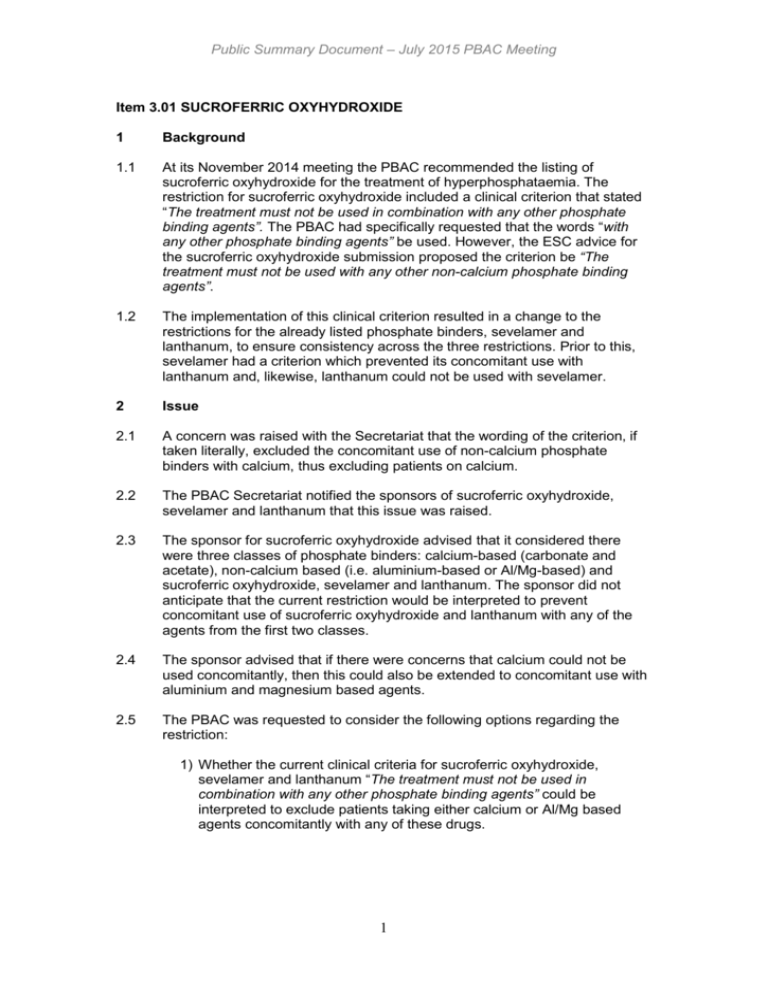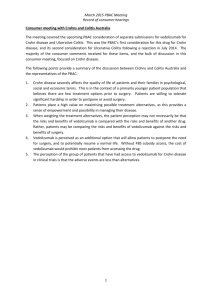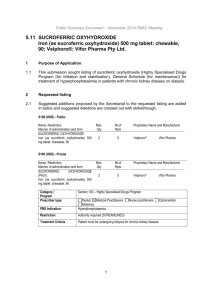Public Summary Document (PSD) July 2015 PBAC Meeting
advertisement

Public Summary Document – July 2015 PBAC Meeting Item 3.01 SUCROFERRIC OXYHYDROXIDE 1 Background 1.1 At its November 2014 meeting the PBAC recommended the listing of sucroferric oxyhydroxide for the treatment of hyperphosphataemia. The restriction for sucroferric oxyhydroxide included a clinical criterion that stated “The treatment must not be used in combination with any other phosphate binding agents”. The PBAC had specifically requested that the words “with any other phosphate binding agents” be used. However, the ESC advice for the sucroferric oxyhydroxide submission proposed the criterion be “The treatment must not be used with any other non-calcium phosphate binding agents”. 1.2 The implementation of this clinical criterion resulted in a change to the restrictions for the already listed phosphate binders, sevelamer and lanthanum, to ensure consistency across the three restrictions. Prior to this, sevelamer had a criterion which prevented its concomitant use with lanthanum and, likewise, lanthanum could not be used with sevelamer. 2 Issue 2.1 A concern was raised with the Secretariat that the wording of the criterion, if taken literally, excluded the concomitant use of non-calcium phosphate binders with calcium, thus excluding patients on calcium. 2.2 The PBAC Secretariat notified the sponsors of sucroferric oxyhydroxide, sevelamer and lanthanum that this issue was raised. 2.3 The sponsor for sucroferric oxyhydroxide advised that it considered there were three classes of phosphate binders: calcium-based (carbonate and acetate), non-calcium based (i.e. aluminium-based or Al/Mg-based) and sucroferric oxyhydroxide, sevelamer and lanthanum. The sponsor did not anticipate that the current restriction would be interpreted to prevent concomitant use of sucroferric oxyhydroxide and lanthanum with any of the agents from the first two classes. 2.4 The sponsor advised that if there were concerns that calcium could not be used concomitantly, then this could also be extended to concomitant use with aluminium and magnesium based agents. 2.5 The PBAC was requested to consider the following options regarding the restriction: 1) Whether the current clinical criteria for sucroferric oxyhydroxide, sevelamer and lanthanum “The treatment must not be used in combination with any other phosphate binding agents” could be interpreted to exclude patients taking either calcium or Al/Mg based agents concomitantly with any of these drugs. 1 Public Summary Document – July 2015 PBAC Meeting 2) If the PBAC considers that the current clinical criterion could be interpreted as excluding concomitant use with calcium and Al/Mg based agents, would the PBAC consider a revision of the criterion to “The treatment must not be used in combination with any other non-calcium, non-aluminium or non-magnesium phosphate binding agents”. 3) If the PBAC considers that concomitant use with Al/Mg phosphate binding agents is unlikely to occur in practice, it may also wish to advise whether a restriction change to “The treatment must not be used in combination with any other non-calcium phosphate binding agents” is more appropriate. 2.6 In the pre-PBAC response, the sponsor for sucroferric oxyhydroxide reiterated that the current clinical criteria was clearly intended to prevent reimbursement of two drugs from the same class (i.e. sevelamer and lanthanum), rather than influencing decisions concerning concomitant treatment with other agents. Despite this, the sponsor advised that they would accept a restriction change to either option 2 or 3. 3 PBAC Consideration 3.1 The PBAC noted the concerns regarding the exclusion of patients taking calcium, aluminium or magnesium based agents concomitantly with sucroferric oxyhydroxide, sevelamer or lanthanum. The PBAC recalled from its November 2014 recommendation that sucroferric oxyhydroxide was not to be used in combination with sevelamer or lanthanum. The PBAC further recalled its request that this be extended further to include other phosphate binders. The PBAC noted the possible interpretation that this clinical criterion would exclude concomitant use with calcium, and clarified that this was not the intent of the listing. 3.2 The PBAC recommended that the clinical criterion for sucroferric oxyhydroxide, sevelamer and lanthanum be amended from “The treatment must not be used in combination with any other phosphate binding agents” to “The treatment must not be used in combination with any other non-calcium phosphate binding agents”. 2 Public Summary Document – July 2015 PBAC Meeting 4 Amended restrictions 4.1 Amendments to the restrictions are italicised. Sucroferric oxyhydroxide, sevelamer and lanthanum: Category / Section 100 – Highly Specialised Drugs Program - Private Program Prescriber type: Dental Medical Practitioners Nurse practitioners Optometrists Midwives Condition: Hyperphosphataemia PBS Indication: Hyperphosphataemia Treatment phase: Restriction Level / Method: Initiation and stabilisation. Treatment criteria: Clinical criteria: Restricted benefit Authority Required - In Writing Authority Required - Telephone Authority Required – Emergency Authority Required - Electronic Streamlined Patient must be undergoing dialysis for chronic kidney disease. The condition must not be adequately controlled by calcium, AND Patient must have a serum phosphate of greater than 1.6 mmol per L at the commencement of therapy, OR The condition must be where a serum calcium times phosphate product is greater than 4 at the commencement of therapy, AND The treatment must not be used in combination with any other non-calcium phosphate binding agents. Category / Program Prescriber type: Section 100 – Highly Specialised Drugs Program – Public Condition: Dental Medical Practitioners Optometrists Midwives Hyperphosphataemia PBS Indication: Hyperphosphataemia Treatment phase: Initiation and stabilisation 3 Nurse practitioners Public Summary Document – July 2015 PBAC Meeting Restriction Level / Method: Treatment criteria: Restricted benefit Authority Required - In Writing Authority Required - Telephone Authority Required – Emergency Authority Required - Electronic Streamlined Patient must be undergoing dialysis for chronic kidney disease. Clinical criteria: The condition must not be adequately controlled by calcium, AND Patient must have a serum phosphate of greater than 1.6 mmol per L at the commencement of therapy, OR The condition must be where a serum calcium times phosphate product is greater than 4 at the commencement of therapy, AND The treatment must not be used in combination with any other non-calcium phosphate binding agents. Category / Program Prescriber type: GENERAL – General Schedule (Code GE) Dental Medical Practitioners Optometrists Nurse practitioners Midwives Condition: Hyperphosphataemia PBS Indication: Hyperphosphataemia Treatment phase: Maintenance following initiation and stabilisation. Restriction Level / Method: Treatment criteria: Restricted benefit Authority Required - In Writing Authority Required - Telephone Authority Required – Emergency Authority Required - Electronic Streamlined Patient must be undergoing dialysis for chronic kidney disease. 4 Public Summary Document – July 2015 PBAC Meeting Clinical criteria: The condition must not be adequately controlled by calcium, AND Patient must have a serum phosphate of greater than 1.6 mmol per L at the commencement of therapy, OR The condition must be where a serum calcium times phosphate product is greater than 4 at the commencement of therapy, AND The treatment must not be used in combination with any other non-calcium phosphate binding agents. Administrative advice Shared care model: For prescribing by nurse practitioners where care of a patient is shared between a nurse practitioner and medical practitioner in a formalised arrangement with an agreed management plan. Further information can be found in the Explanatory Notes for Nurse Practitioners. 5 Context for Decision The PBAC helps decide whether and, if so, how medicines should be subsidised in Australia. It considers submissions in this context. A PBAC decision not to recommend listing or not to recommend changing a listing does not represent a final PBAC view about the merits of the medicine. A company can resubmit to the PBAC or seek independent review of the PBAC decision. 6 Sponsor’s Comment Fresenius Medical Care thank the PBAC for its timely and proactive clarification of the PBS restriction wording relating to sucroferric oxyhydroxide (Velphoro). 5






